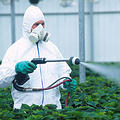 美國環保署認為化學殺蟲劑「加保扶」(carbofuran)(譯註,即台灣常見農藥「好年冬」)有危害人體健康與環境的嚴重風險,計畫將容許食物殘留加保扶的規定取消。環保署這項禁止加保扶殘留的提案由7月30日開始接受公眾評論。
美國環保署認為化學殺蟲劑「加保扶」(carbofuran)(譯註,即台灣常見農藥「好年冬」)有危害人體健康與環境的嚴重風險,計畫將容許食物殘留加保扶的規定取消。環保署這項禁止加保扶殘留的提案由7月30日開始接受公眾評論。
加保扶是一種「氨基甲酸鹽類」殺蟲劑與殺線蟲藥,登記用途是控制土壤與各種田野穀物及蔬果葉片上的害蟲,但不包括在民宅使用。
環保署認定,不論是哪一種用途,加保扶對於食用者、施用者與生態都造成可觀的威脅。含有加保扶的產品通常會「對人體與環境造成預期外的負面影響,不符合安全標準」,因此不適合繼續取得登記許可。在規定修改完畢後,加保扶的法定食物殘留標準將被調降為零。
加保扶是白色、結晶狀的固體,帶有輕微的酚類氣味。在剛開始出現甲蟲、線蟲或根蟲的時候,會將這種廣效殺蟲劑直接噴灑在土壤或植物上以控制蟲害。
苜蓿與水稻是最常施用加保扶的作物,其次是草皮和葡萄,早期則主要用於玉米。
若短暫吸入加保扶這種化學物質,環保署發現可能會導致頭痛、盜汗、噁心、腹瀉、胸痛、視線模糊、焦慮與肌肉疲勞等症狀,但治療後可以得到緩解。環保署表示,長期暴露於加保扶可能會對神經與生殖系統造成損害。
加保扶有許多商品名稱與暱稱,包括Niagara 10242、Brifur、Chinufur、Curaterr、Yaltox等,但最常見的品名是Furadan,由跨國化學公司富美實(FMC)製造供應。
雖然美國糧食作物只有小部份使用加保扶,由食物攝入的可能性不高,但環保署的測試顯示「其風險不符合美國嚴格的食品安全標準」,為了因應這種殺蟲劑對施用者與田間鳥類的可能危害,環保署決定取消登記許可。
加保扶被施用在田間之後,會被雨水沖刷帶進河川湖泊,或者會由植物根部滲透進入地下水中。環保署估計,在早期加保扶尚未被限制為緊急用農藥的時候,每年約有2百萬隻鳥被毒死。
富美實公司在25日發表聲明,認為「加保扶食物殘留應不至對人體健康造成威脅」。該公司打算修改產品標籤,其中仍會保留對5種作物的用途,因為在嚴重蟲害的狀況下,除了加保扶,目前並沒有其他有效方法可控制。
富美實農業商品集團的北美法規部經理康明思(John Cummings)表示,「如果按照最科學的方式使用,加保扶對食品與其他綜合的風險都是可以接受的,不若環保署報告中誇大的程度。」
加保扶進入土壤或水中以後,會被反應性化學物質與微生物分解,而且在鹼性環境中分解較快。環保署指出,加保扶可能滲透到各種性質的土壤內,例如紐約與威斯康辛州砂質土壤區的地下水就曾經檢測到加保扶。
加保扶的使用從1992年開始受到限制,在1993年到1995年間,環保署要求水公司每三個月進行一次採樣,分析水中的加保扶濃度是否超過0.9 ppb(即900億分之1)。
一旦高於標準,水公司就要持續監視污染狀況,若污染一直超過上限,水公司必須使用活性碳顆粒降低加保扶含量。
除了提案降低食物殘留標準,環保署也公佈他們對美國科學顧問小組(Scientific Advisory Panel)審查的回應。農業部(USDA)也曾指出禁止加保扶對美國農業經濟所造成的影響,環保署也對此一併做出回應。
農業部認為,雖然需要使用加保扶的情況不多,這種殺蟲劑在經濟上仍然重要,而且部份用途符合登記使用的資格。
農業部宣稱,在對付玉米根蟲的時候,如果各種方法均告失敗,包括Bt基改抗蟲玉米等生物工程技術也無法奏效的情況下,只有使用加保扶才能緊急挽救,否則估計每英畝的損失將高達1千美元。
然而環保署否定這樣的說法,認為「即使是現有的最低用量,加保扶仍持續對野外生物造成負面危害,並且嚴重污染飲水。」
最新的一起案例,是2006年科羅拉多州向日葵田使用加保扶,造成2200隻鳥類死亡。2000年也有類似狀況,有800到1200隻雪鵠(snow goose)和鴨子,因為接觸了施用液態加保扶的苜蓿田而死亡。
環保署認為,這些回報案例可能只是真實情況的冰山一角,因為動物是死在人煙稀少的農業地帶,很不容易被發現注意。
環保署禁止加保扶食物殘留的提案將有60天接受公共評論,詳情請見此網頁。
Due to "considerable risks" of damage to human health and the environment associated with the pesticide carbofuran, the U.S. Environmental Protection Agency is revoking the regulations that allow carbofuran residues in food.
EPA's carbofuran tolerance revocation proposal will be published for public comment on July 30, 2008.
Carbofuran is an N-methyl carbamate insecticide and nematicide registered to control pests in soil and on leaves in a variety of field, fruit, and vegetable crops. No residential uses are registered.
EPA has concluded that dietary, worker, and ecological risks are of concern for all uses of carbofuran. All products containing carbofuran generally cause "unreasonable adverse effects on humans and the environment and do not meet safety standards," and therefore are ineligible for reregistration. When the revocation process is completed, the legal residue limits for carbofuran on food will be reduced to zero.
Carbofuran is a white crystalline solid with a slightly phenolic odor. A broad spectrum insecticide, it is sprayed directly onto soil and plants just after emergence to control beetles, nematodes and rootworm.
The greatest use of carbofuran is on alfalfa and rice, with turf and grapes making up most of the remainder. Earlier uses were primarily on corn crops.
When people are exposed to carbofuran for a short period of time, the EPA has found the chemical to potentially cause headache, sweating, nausea, diarrhea, chest pains, blurred vision, anxiety and general muscular weakness. These effects are reversible, the agency said. Long-term exposure to carbofuran has the potential to cause damage to the nervous and reproductive systems, said the EPA.
Trade names and synonyms for carbofuran are: Niagara 10242, Furadan 4F or 3G, Brifur, Crisfuran, Chinufur, Curaterr, Yaltox, Pillarfuran, and Kenofuran. It is most commonly marketed under the trade name Furadan, by the publicly traded chemical company FMC Corporation.
Even though carbofuran is used on a small percentage of the U.S. food supply and therefore the likelihood of exposure through food is low, EPA says tests have identified "risks that that do not meet our rigorous food safety standards." EPA is cancelling the pesticide registration, which will address the risks to pesticide applicators and birds in treated fields.
Carbofuran enters surface water as a result of runoff from treated fields and enters ground water by leaching of treated crops. The EPA's estimates show that up to two million birds were killed each year by carbofuran before it was banned for all but emergency uses.
FMC Corporation said in a statement Friday that it "believes strongly that carbofuran residue on food does not pose a threat to human health."
FMC has proposed a revised product label retaining uses of five crops where there are no viable alternatives for critical pest control. "Dietary and aggregate risks to carbofuran are acceptable when the best available science is used, contrary to the exaggerated risks as reported by EPA," said John Cummings, North America regulatory manager, FMC Agricultural Products Group.
If released to soil or water, carbofuran is broken down by reactive chemicals and microbes, particularly in alkaline conditions. Carbofuran may leach in many soils, as has been seen in the detection of carbofuran in sandy aquifers in New York and Wisconsin, the EPA said.
The regulation for carbofuran became effective in 1992. Between 1993 and 1995, the EPA required water suppliers to collect water samples every three months for a year and analyze them to find out if carbofuran is present above 0.9 parts per billion, ppb. If it is present above this level, the system had to continue to monitor this contaminant.
If contaminant levels are found to be consistently above the maximum contaminant level, water suppliers have had to reduce the amount of carbofuran using granular activated charcoal.
As part of this effort, EPA is also releasing its response to the peer review conducted by the independent Scientific Advisory Panel and the agency's response to the U.S. Department of Agriculture's comments on the effect of the cancellation of carbofuran on the agricultural economy.
The USDA says that, despite the limited use of carbofuran in most agricultural situations, the pesticide is economically important and some uses, at least, qualify for reregistration.
The USDA claims that carbofuran "is the only feasible post-emergent rescue treatment" for corn rootworm if other options fail, including varieties bioengineered for insect resistance such as Bt corn. Without a rescue treatment, the USDA asserts that grower losses could be as high as $1,000 per acre.
But the EPA does not agree, saying, "Even at the lower current usage, carbofuran use continues to result in serious adverse wildlife incidents, and significant water contamination. For example, a recent incident in 2006 included the deaths of 2,200 birds fiom carbofuran use in a sunflower field in Colorado. Similarly an incident in 2000 included the deaths of 800-1,200 snow geese and ducks following exposure to alfalfa in fields treated with flowable carbofuran.
EPA says reported incidents likely represent only a small fraction of the adverse incidents that are in fact occurring. The agency points out that kills are not likely to be noticed in agricultural environments, which are generally away from human activity.
EPA will accept public comments on the proposed tolerance revocation for 60 days. To find out more, click here. http://www.epa.gov/pesticides/reregistration/carbofuran/carbofuran_noic.htm
全文及圖片詳見:ENS




